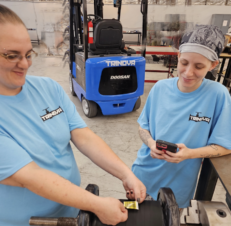By Charlie Uglietto, Cubby Oil & Energy
By now, there’s no doubt you’re aware that strategic electrification has been eroding the hydronic market for a number of years. Heat pumps of every shape and size are being selected in place of boiler retrofits.
That’s a disservice to the customer, due to the longevity, efficiency and comfort advantages that hydronic systems offer, and it means lost revenue for mechanical contractors and energy delivery companies. Reducing the nation’s home heating carbon footprint is a noble cause, but the effectiveness of our efforts will be determined by the methods we use to achieve the goal. There are better alternatives than electrification, and the best option we have available right now, at least for homes with an existing oil boiler, is Bioheat® fuel.

Bioheat is a liquid fuel oil alternative that’s 100% renewable and available right now. It can be produced from a variety of renewable agricultural products including soybean oil, inedible corn oil, used cooking oil, fats, tallow, canola oil and other recycled oils. Better yet, Bioheat can be used in new or existing oil boilers with minimal if any modifications necessary to the boiler.
Unpacking Electrification
“The people that stand to lose the most from electrification, aside from oil dealers, are those in lower-income households,” said Paul Nazzaro, president of Advanced Fuel Solutions. “Why should families who struggle to put food on the table need to pay $20,000 to retrofit their home with heat pumps?”
For more than 25 years, Nazzaro has helped secure biodiesel’s place as one of the fastest growing alternative fuels in the nation. He has written and presented extensively on all facets of biodiesel production. As the supply chain liaison for the National Biodiesel Board, he was a key figure in the conceptualization of Bioheat fuel.
A recent study by ICF International concluded that policy-driven electrification would increase the average residential household energy-related costs by approximately 38% to 46%, resulting in an increase to the average affected residential household of between $750 and $910 annually. Additionally, the electrification movement isn’t as green as it would lead you to believe. As of right now, only a small portion of the nation’s electric energy is produced with renewables, and the percentage of renewable vs. of fossil fuel energy production drops further with the onset of heating season, when standby fossil fuel-powered generation is brought online to handle the increased load.
 Electrification does not reduce fossil fuel use. It simply changes where fossil fuel is being consumed. The further this trend goes, the less fuel oil is been used for heating.
Electrification does not reduce fossil fuel use. It simply changes where fossil fuel is being consumed. The further this trend goes, the less fuel oil is been used for heating.
“We used to have a 10+ billion gallon/year residential heating oil market,” said Nazzaro. “That number is now 4 billion, 3.2 of which is consumed in New England, N.J., N.Y. and Pa. alone. That’s serious market erosion.”
Luckily for mechanical contractors whose businesses rely heavily on hydronics, the use of Bioheat is a solution that can be implemented immediately to stop and even reverse the loss of market share, while simultaneously increasing the country’s use of renewable energy.
Renewable, Low Carbon and Feasible
As an ultra-low carbon, liquid heating fuel, Bioheat is renewably-sourced, nontoxic and biodegradable. As bio-blends have increased over the past few years, burner manufacturers Beckett Corporation and Carlin Combustion Technology have been in touch with me, NORA and other dealers to gauge our experiences with higher blends. At times, I’ve had their engineers ride along with me to visit homes using high blends of Bioheat.
“Based on my conversations with Beckett and Carlin, converting from fuel oil to Bioheat isn’t a conversion at all,” explained Nazzaro. “Simple air adjustments may be needed on the burner because Bioheat is more oxygenated than fuel oil.”
Bioheat is currently available in three blends, each mixed with #2 fuel oil: B10 (10% Bioheat), B20 (20% Bioheat) and B50 (50% Bioheat). B100, which is also available, does not include any fossil fuel whatsoever.
“Homes in Washington State have been using B100 for a number of years, and well over 100,000 homes in the Northeast have been using B20,” said Robert O’Brien, research and technical consultant for NORA (National Oilheat Research Alliance). “Even at 100 percent biofuel, old burners are capable of using it with a few adjustments.”

“There are very few barriers to large-scale implementation of Bioheat,” continued O’Brien. “Homeowners are open to it, especially younger ones. It’s cleaner, it’s cost-competitive, and it’s renewable. It’s the oil industry’s answer to the carbon problem, and a very, very good answer at that.”
The Providence Resolution—which proposes to reduce greenhouse gas emissions in heating oil by 15% by 2023, 40% by 2030, and reach “net-zero” fuel by 2050—was approved at the 2019 Industry Summit in Providence, R.I., on September 16, 2019.
“Those are lofty goals, but entirely achievable,” said Nazzaro. “The only way they’re possible is for heating professionals to commit to the use of Bioheat.”
Such confidence doesn’t come unfounded, though. Before the Providence Resolution was approved, consulting agency A.T. Kearny was hired by NEFI (National Energy and Fuels Institute) to determine whether or not net-zero carbon emissions were a possibility for the liquid fuel industry.
Having advised many of the biggest governments around the world and three-fourths of the Fortune 500 list, consultancy A.T. Kearney is regarded as one of the world’s foremost consulting partnerships in the energy space.
“We came to the conclusion that yes, successfully achieving the goals laid out in the Providence Resolution is achievable,” said Neal Walters, a partner at A.T. Kearny “That’s the reality.”
How? By adopting a B20 Bioheat fuel blend by 2023, B50 by 2030, and B100 by 2050. Some skeptics may wonder if producing 4 billion gallons of a plant- and recycled oil-based fuel is possible in a year.
Supply Capabilities
“People need to understand the upstream,” said Nazzaro. “Not only is the soybean industry capable of it, but there are countless feedstocks for biofuel. The volume of recycled oil in this country alone is staggering.”
Kearney’s research indicates that much, if not all, of the required supply, infrastructure and production capacity already exists.
“Today, the northeastern U.S. produces about 150 million gallons of biodiesel per year, and to get a B20 blend [to completely replace #2 fuel oil] by 2023 we’ll need 800 million gallons per year,” said Yuri Kopylovski, a manager at Kearney. “That might seem like a pretty big increase, but in 2019, North American production capacity was about 3 billion gallons, and only 1.7 billion gallons were actually produced.” The capacity figure accounted for biodiesel plants in the U.S. and Canada. “This means that with existing plant infrastructure, we have about a 73 percent increase in production that could be made without any additional capital investment or reliance on imports from outside North America.”
The future is bright for renewable liquid fuel, but only if heating professionals act now.
Educating Consumers
As heating professionals, we have a very crucial role to play in the future of low-carbon energy mix. We must educate consumers on our ability to immediately reduce greenhouse gas emissions in the heating sector at little or no cost to them. The time to act is right now. There is no time left.
A wholesale executive predicted to me that if we don’t act within five years, we will have lost 35 to 50 percent of our customer base. ISO-New England is predicting that they can convert 750,000 homes from fossil fuels to heat pumps within the next five years. That’s a lot of customers to lose and a lot of delivered gallons lost. Now is the time we need to invest in our industry.
The most important thing mechanical contractors and fuel delivery companies can do is to realize that status quo won’t work. They need to embrace change.
“What’s great about our industry is that we have a product that allows us to change very quickly,” said Nazzaro. “Propane and natural gas can’t pivot like we can because they don’t currently have a renewable alternative that’s scalable nationwide. We do. Implementing Bioheat is more than defense. It’s a long term play.”
Aside from NORA, NEFI, and a host of other organizations, the largest, most progressive energy delivery companies in the country have already committed to the change. In 2021 for example, PETRO (the largest fuel oil dealer in the US) made a commitment to deliver only B20 or higher blends as supply commitments are coordinated between PETRO and their wholesale partners. My company, Cubby Oil & Energy, has also made the same commitment.
Our location gives us access to a number of wholesalers that sell biodiesel blends. There are parts of the country where these blends aren’t as readily available, but that’s changing rapidly. More and more wholesalers are starting to provide biodiesel blends at their terminals.”
Those wholesalers and oil dealers that refuse to offer biofuel blends risk being regulated out of existence. Massachusetts has implemented a new APS (alternative portfolio standard) incentive program including 80 dealers, in which the dealer receives an energy credit for every 33 gallons of B100 sold. Connecticut, Rhode Island and New York have blending mandates which are increasing the amount of renewable fuel being sold. In those three states, B50 will be the minimum standard by no later than 2035.
“The industry has made a commitment to liquid renewable fuel,” said Nazzaro. “We’re part of the solution to greenhouse gas reduction, not part of the problem. We’re doing now what others are hoping to accomplish later.”
“Installers of hydronic systems should be educating themselves,” he continued. “They should be speaking with their organizations about actions either being taken or that can be taken, and they should be educating customers.”
There are a variety of resources available to contractors right now:
- MyBioHeat.com is an excellent source of information for the consumer.
- NEFI.com hosts much of the latest Bioheat news concerning incentives, legislation and regulations.
- NORA, which has conducted a great deal of research on Bioheat’s use, transportation, handling and performance, publicizes information at Renewable Fuels – National Oilheat Research Alliance (noraweb.org) in order to help everyone in the industry transition to the renewable fuel.
- Cubby Oil’s website has an entire page dedicated to educating customers Clean-burning Bioheat® and Dependable Bioheat Delivery – Cubby Oil
“We are gaining momentum but we’re far from mature,” said Nazzaro. “We can’t compete with the utilities or heat pump manufacturers from an ad budget standpoint, so dealers need to educate themselves and talk with customers. I believe this will be the biggest lost opportunity our industry will ever see if we don’t act right now. You can have an impact today!”
 Charlie Uglietto owns Cubby Oil & Energy in Boston, Mass. In addition to his 45 years’ experience in the deliverable fuels industry, Uglietto has been instrumental in deploying higher blends of Bioheat over the past decade. Despite owning the company, he spends plenty of time in the field and holds pipefitter, burner and HVAC licenses.
Charlie Uglietto owns Cubby Oil & Energy in Boston, Mass. In addition to his 45 years’ experience in the deliverable fuels industry, Uglietto has been instrumental in deploying higher blends of Bioheat over the past decade. Despite owning the company, he spends plenty of time in the field and holds pipefitter, burner and HVAC licenses.



